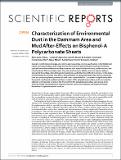Characterization of Environmental Dust in the Dammam Area and Mud After-Effects on Bisphenol-A Polycarbonate Sheets
Author(s)
Yilbas, Bekir Sami.; Ali, Haider; Al-Aqeeli, Naseer; Khaled, Mazen M.; Said, Syed; Abu-Dheir, Numan; Merah, Necar; Varanasi, Kripa; Youcef-Toumi, Kamal; ... Show more Show less
DownloadYilbas-2016-Characterization.pdf (2.211Mb)
OPEN_ACCESS_POLICY
Open Access Policy
Creative Commons Attribution-Noncommercial-Share Alike
Terms of use
Metadata
Show full item recordAbstract
Owing to recent climate changes, dust storms are increasingly common, particularly in the Middle East region. Dust accumulation and subsequent mud formation on solid surfaces in humid environments typically have adverse effects on surface properties such as optical transmittance, surface texture, and microhardness. This is usually because the mud, which contains alkaline and ionic species, adheres strongly to the surface, often through chemical bonds, and is therefore difficult to remove. In this study, environmental dust and the after-effects of mud formed on a polycarbonate sheet, which is commonly used as a protective glass in photovoltaic cells. Ionic compounds (OH−) are shown to significantly affect the optical, mechanical, and textural characteristics of the polycarbonate surface, and to increase the adhesion work required to remove the dry mud from the polycarbonate surface upon drying. Such ability to modify characteristics of the polycarbonate surface could address the dust/mud-related limitations of superhydrophobic surfaces.
Date issued
2016-04Department
Massachusetts Institute of Technology. Department of Mechanical EngineeringJournal
Scientific Reports
Publisher
Nature Publishing Group
Citation
Yilbas, Bekir Sami., Haider Ali, Naseer Al-Aqeeli, Mazen M. Khaled, Syed Said, Numan Abu-Dheir, Necar Merah, Kamal Youcef-Toumi, and Kripa K. Varanasi. “Characterization of Environmental Dust in the Dammam Area and Mud After-Effects on Bisphenol-A Polycarbonate Sheets.” Scientific Reports 6 (April 14, 2016): 24308. © 2016 Macmillan Publishers Limited
Version: Final published version
ISSN
2045-2322